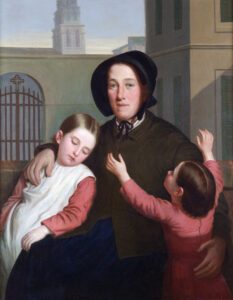Margaret Haughery
Margaret Gaffney Haughery was a successful business entrepreneur and noted philanthropist of nineteenth-century New Orleans.

Courtesy of Roger H. Ogden Collection
Margaret. Amans, Jacques Guillaume Lucien (artist)
Margaret Haughery was an illiterate Irish laundress, a peddler, a dairymaid, a baker, a business entrepreneur, and a noted philanthropist in Louisiana. Haughery started her first business with small savings she earned while working as a laundress; her second business consisted of turning around a near-bankrupt bakery. Upon her death in 1882, her pallbearers included the current and previous governors of Louisiana, the mayor of New Orleans, and the archbishop. She left $13,000 to six orphan asylums and two asylums for widows or mothers with dependent children. She paid off the debt owed by St. Elizabeth’s House of Industry and left the rest, $30,000, to the Sisters of Charity with instructions that it be used to maintain St. Vincent’s Infant Asylum. The total amount of her bequest exceeded $50,000.
Haughery arrived in New Orleans in 1835 with her newlywed husband, Charles Haughery, and gave birth to a daughter shortly thereafter. Within the year, both husband and daughter died. Finding herself a widow with few resources in a new city, Haughery supported herself by working as a laundress for the St. Charles Hotel. She also became involved in the orphan asylum run by the Sisters of Charity.
The Catholic Church and, specifically, the orphans under the care of the Sisters of Charity figured prominently in Haughery’s life, and she supported both financially throughout her life. She collected clothing and furniture and begged for food and cash donations from nearby businesses and restaurants. In exchange, the Sisters of Charity gave her a free room in the orphanage. This arrangement allowed Haughery to save enough to purchase two dairy cows with the intent to ensure that the orphans always had fresh milk to drink. Gradually she began to sell the surplus to neighbors, and soon her business thrived.
Haughery expanded her dairy clientele by using a milk cart, and within two years increased her herd to forty cows. She personally maintained the operation of the milk cart and enlarged the product range to include cream and butter. On her tours, she also solicited goods and donations for the children, filling her cart with donations as she emptied it of its cargo of milk. She reinvested part of her earnings in her dairy business but also provided low-interest loans to other businesses. For the remainder of her life, Haughery donated the bulk of her earnings to the work of the Sisters of Charity. Working closely with Sister Regis, head matron of the Sisters of Charity and the New Orleans Female Orphan Asylum, whom Haughery credited with helping her through her double bereavement, she helped to establish and fund three orphan asylums and the building St. Theresa of Avila Church.
Over several years, Haughery had made numerous loans to the D’Aquin Bakery. The loans were collateralized by stock in the bakery, and in 1859 she became the majority owner of the nearly bankrupt business. Haughery quit the dairy business to concentrate on the failing bakery and saved the bakery from bankruptcy, turning it into a successful business enterprise. She expanded both product line and clientele, selling bread, cakes, crackers, cookies, flour, and even macaroni. Moreover, she convinced many shipping merchants to allow her to supply the bread for their vessels, and as a result, her reputation began to spread across the United States. She invented a method of packaging crackers that made it possible to ship them “fresh” to other cities. When Haughery’s bakery began to package crackers, she shipped them on those vessels that she already supplied with her bread products. During this entire time she never neglected the orphanages she helped to create, supplying them with bread at cost. She also gave free bread to any who claimed to be in need.
Haughery personally oversaw all aspects of her business, employing forty men whose occupations ranged from clerk to errand boy, but refusing to employ department heads. As her business grew, she investigated and invested in the latest improvements, and thus, hers became the first bakery in the South to operate machinery by steam. This efficient operation allowed her to expand even more until she had built the largest bakery in the United States. Her flour depot was capable of manufacturing 800 barrels of flour for sale per day in addition to what she needed to make her own bread products.
One of the first statues erected in the United States in honor of a woman is of Margaret Haughery, commemorating the success of her businesses and her wide-raging philanthropic endeavors. The statue was completed in 1884 and is located near St. Theresa of Avila Church.
